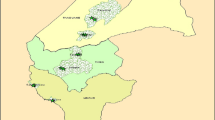Abstract
Ancient tea garden has existed in Lancang County, Yunnan Province for more than 1,300 years, and is regarded as the provenance of Pu’er Tea’s seed source. The ancient tea garden ecosystem is a typical model that integrates conservation biodiversity and utilization of natural resources. In order to reveal the role of biodiversity conservation of this ecosystem, plant diversity and application value of ancient tea gardens, normal tea gardens and secondary forestry communities in Lancang County were surveyed and compared. 360 households investigation were also conducted by using household-based agro-biodiversity assessment (HH-ABA). The results showed: (1) Ancient tea garden communities have high biodiversity, whose plant species diversity (H = 3.03) is lower than that of secondary forestry (H = 4.59) and higher than that of normal tea garden (H = 2.62); (2) Life forms analysis of plant species showed the vertical structure of the ancient tea garden communities are intact, herbs, trees, shrubs, vines, epiphytes are included, which is similar to that of secondary forest, while normal tea garden is dominant by herbs and no trees; (3) A large number of protected species, including five endangered, seven vulnerable and three rare, is well conserved in the ancient tea garden, while no protected species were found in secondary forest and normal tea garden; (4) The analysis of agro-biodiversity revealed that 56 % of plant species in the ancient tea garden are effectively used by households, while no plant except tea trees is used in normal tea garden; (5) The integrated values of ancient tea garden and normal tea garden illustrated that both biodiversity conservation and economic income of ancient tea garden are higher than that of normal tea garden. We suggest that the local peoples’ knowledge and experience on resource management and utilization should be well documented and encouraged, and effective conservation and reasonable utilization of ancient tea garden would be achieved through training and demonstration with the participation of the local government, research institution and farmer.



Similar content being viewed by others
References
Baskin Y (1995) Ecosystem function of biodiversity. Biological. Science 44:657–660
Committee of Chorography of Lancang Lahu Nationality Autonomous County, Yunnan Province (CCLLNACYP) (1996) Chorography of Lancang Lahu Nationality Autonomous County. Yunnan People’s Press, Kunming
Dao ZL, Guo HJ, Duan JG et al (2001) Household-based agrobiodiversity assessment (HH-ABA) of paddy fields of Gaoligongshan region. Acta Botanica Yunnanica 23(Suppl. XIII):128–139
Feng YZ, Wang HH, Long YM et al. (1982) Rational utilization of sunlight water and soil in the tropical artificial plant communities. In: Xishuangbanna Tropical Botanical Garden (ed) Academic paper compilation of tropical plant I. Yunnan People’s Press, Kunming, p 42–54
Fu LK, Jin JM (1992) The red data book of China’s plant: rare and endangered plants. Science Press, Beijing
Guo HJ, Christine P (1995) Patterns and institutional management of agroforestry systems in Yunnan: an approach for upland rural development. Glob Environ Chang 5:273–279
Guo HJ, Long CL (1998) Agrobiodiversity. In: Guo HJ, Long CL (eds) Biodiversity of Yunnan, SW China. Yunnan Science & Technology Press, Kunming, p 107–120
Guo HJ, Dao ZL, Harold B (1996) Agrodiversity and bio-diversity on the ground and among the people: methodology from Yunnan. PLEC News and Views 6:14–22
Guo HJ, Christine P, Fu YN et al (2000a) Household level agrobiodiversity assessment (HH-ABA). PLEC News and Views 16:28–33
Guo HJ, Christine P, Fu YN (2000b) Agrobiodiversity assessment and in situ conservation. Acta Botanica Yunnanica 22(Suppl. XII):27–41
He PK, He J, Zhang ZB (2000) Minorities and Pu’er tea of Yunnan. In: He PK, Yu DJ, Li WC (eds) Forests trees and minorities. Yunnan Minorities Press, Kunming, p 150–172
Jaccard P (1908) Nouvelles recherches sur la distribution florale. Bull Soc Vaud Sci Nat 44:223–270
Li YH, Pei SJ, Xu ZF (1996) List of higher plants in Xishuangbanna, 2nd edn. Yunnan Nationalities, Kunming
Liu BY, Sun XM, Song WX et al (2010) Geographic distribution, diversity and utilization of ancient tea plants from Xishuangbanna area in Yunnan. Chin Agric Sci Bull 26:344–349
Long CL, Li YH, Wang JR et al (1997a) Structure, function, and impact upon biodiversity of traditional teagarden of Jinuo. In: Pei SJ et al (eds) Collected research papers on biodiversity in swidden agroecosystems in Xishuangbanna. Yunnan Education Press, Kunming, pp 74–83
Long CL, Wang JR, Li YH et al (1997b) Traditional teagarden ecosystems of Xishuangbanna. In: Pei SJ et al (eds) Collected research papers on biodiversity in swidden agroecosystems in Xishuangbanna. Yunnan Education Press, Kunming, pp 57–64
Ma KP (1994) Measurement of biotic community diversity I. alpha diversity (Part 1). Chin Biodivers 2:162–168
Ma KP, Liu YM (1994) Measurement of biotic community diversity I. alpha diversity (Part 2). Chin Biodivers 2:231–239
Margalef R (1965) Composición y distribución del fitoplancton. Mem Soc Cienc Nat La Salle 25:141–205
Pielou EC (1966) The measurement of diversity in different types of biological collections. J Theor Biol 13:131–144
Shannon CE, Wiener W (1963) The mathematical theory of communities. University of Illionis Press, Urbana
Shen PP, Hao C, Liu XM (2007) Research of ancient tea tree in Yunnan Province and countermeasures of protection. China Bus Mark 6:23–26
Whittaker RH (1960) Vegetation of the Siskiyou Mountains, Oregon and California. Ecol Monogr 30:279–338
Zarin JD, Guo HJ, EnuKwesi L (1999) Methods for the assessment of plant species diversity in complex agricultural landscapes: guidelines for data collection and analysis from the PLEC biodiversity advisory group (GEF/PLEC-BAG). PLEC News Views 13:3–16
Acknowledgments
This research was supported by the Cooperation Project between Yunnan Province and Academies/Universities (No. YKS200204) and Natural Science Foundation of Yunnan Province, China (No. 2004C0052 M).
Author information
Authors and Affiliations
Corresponding author
Rights and permissions
About this article
Cite this article
Qi, DH., Guo, HJ. & Sheng, CY. Assessment of plant species diversity of ancient tea garden communities in Yunnan, Southwest of China. Agroforest Syst 87, 465–474 (2013). https://doi.org/10.1007/s10457-012-9567-8
Received:
Accepted:
Published:
Issue Date:
DOI: https://doi.org/10.1007/s10457-012-9567-8




